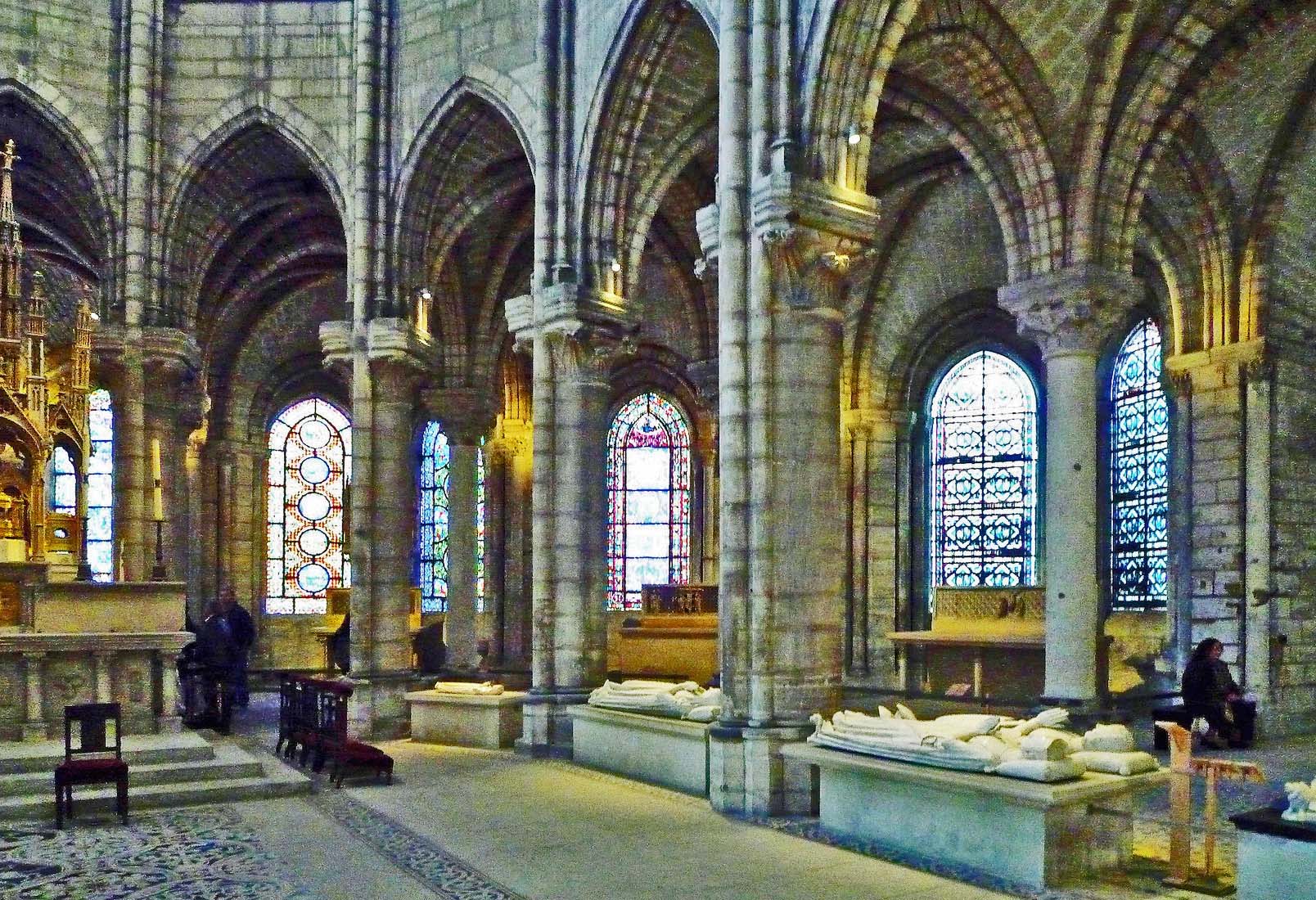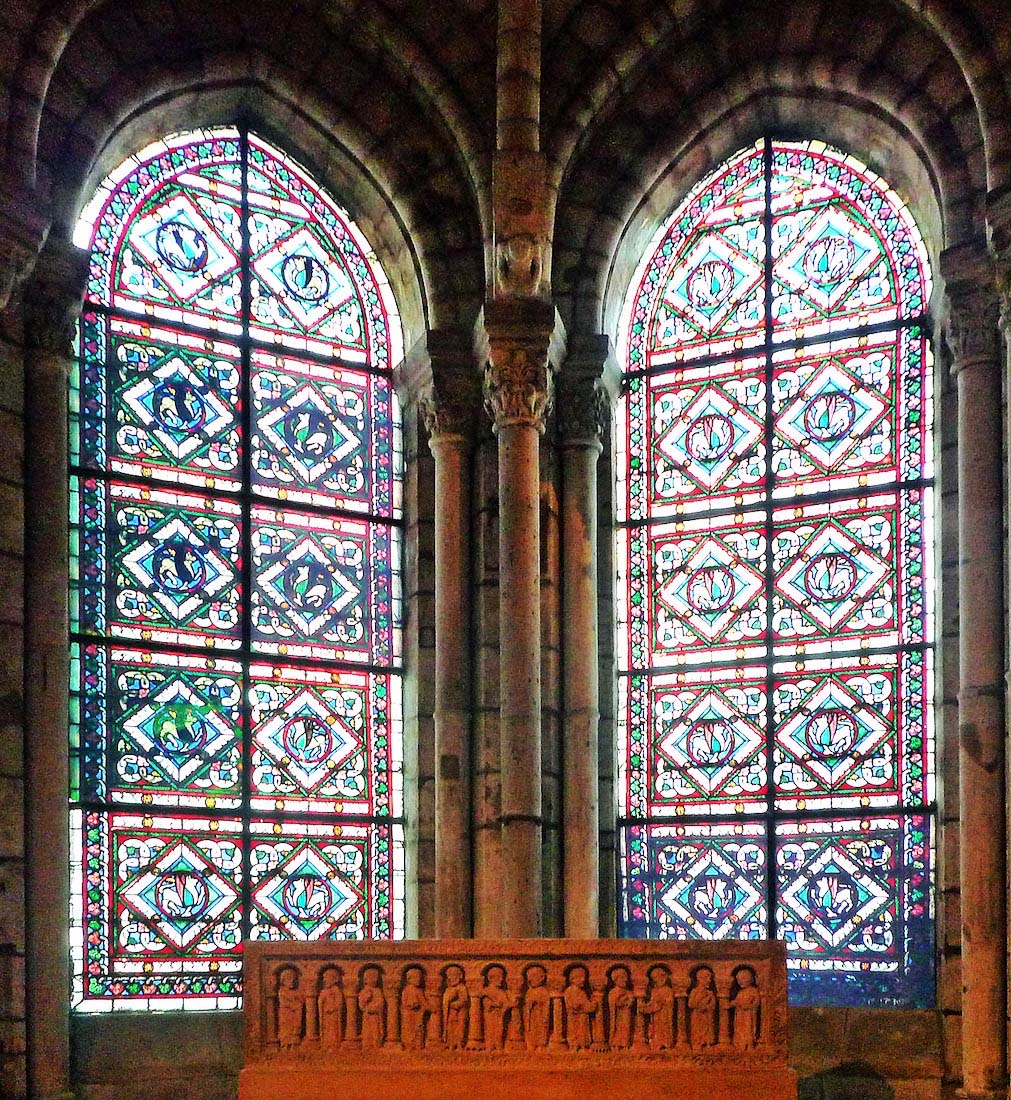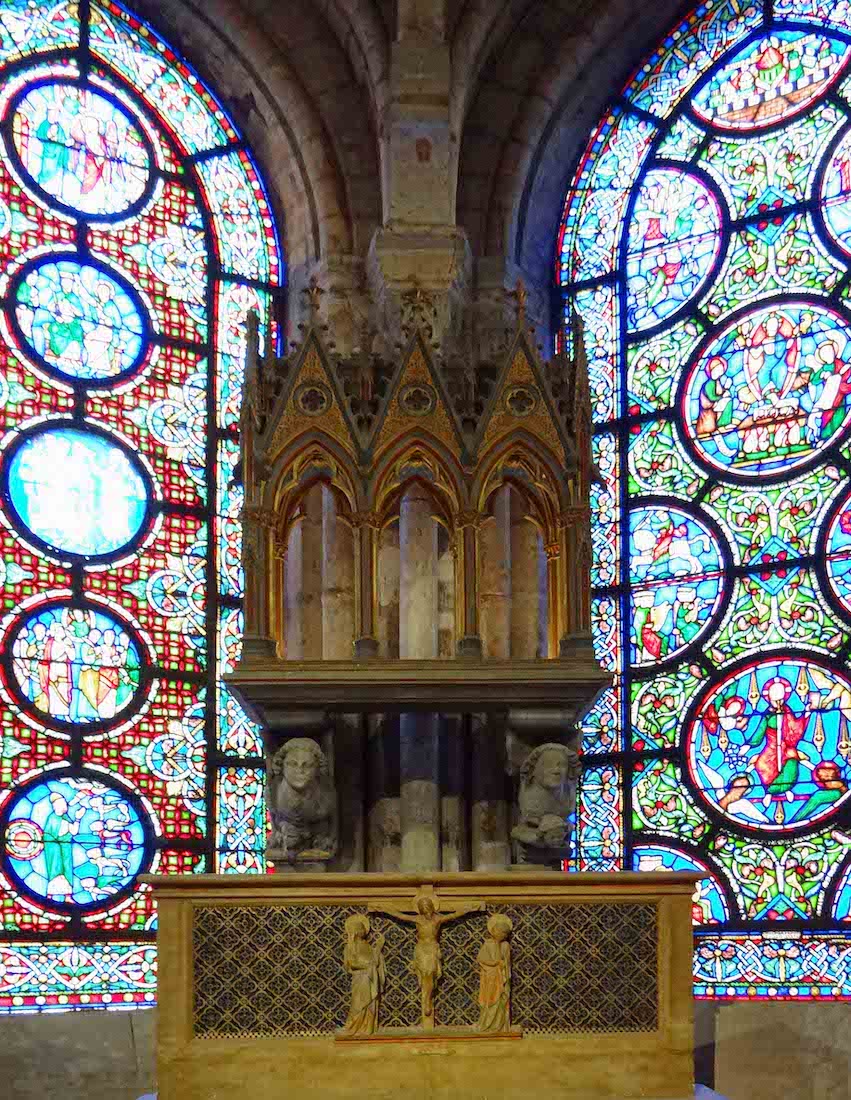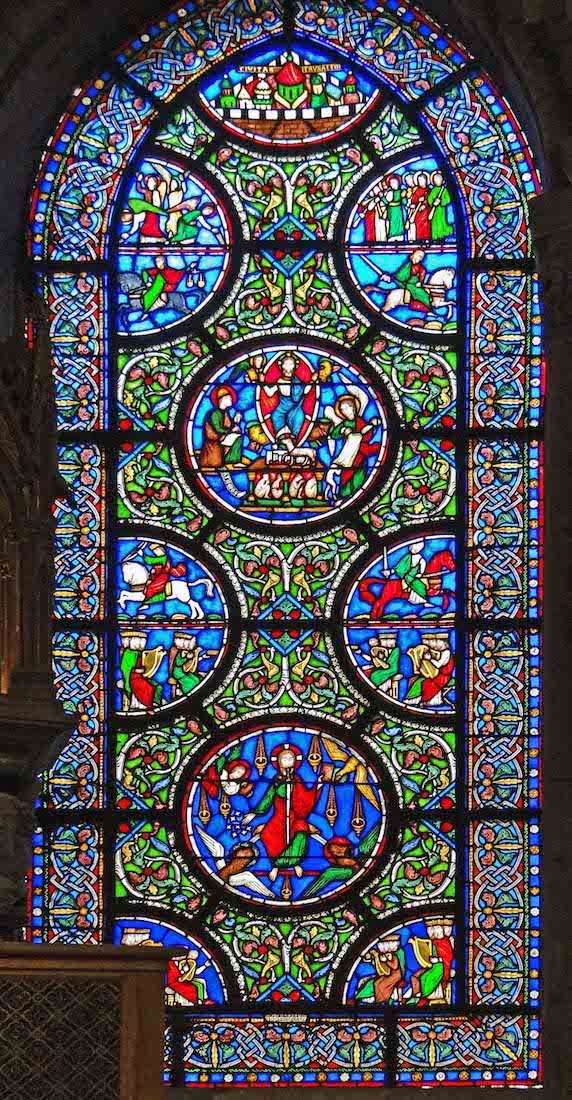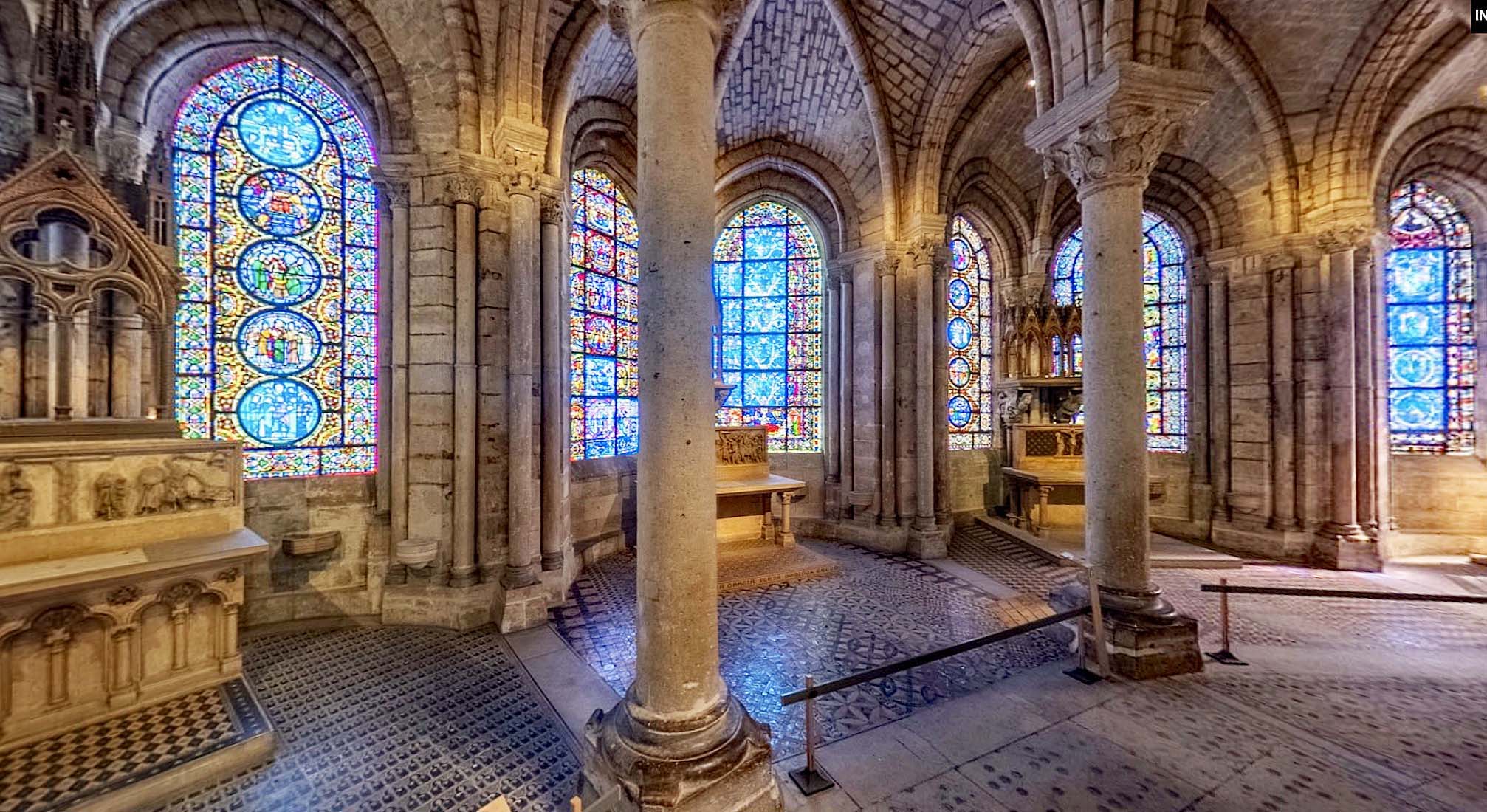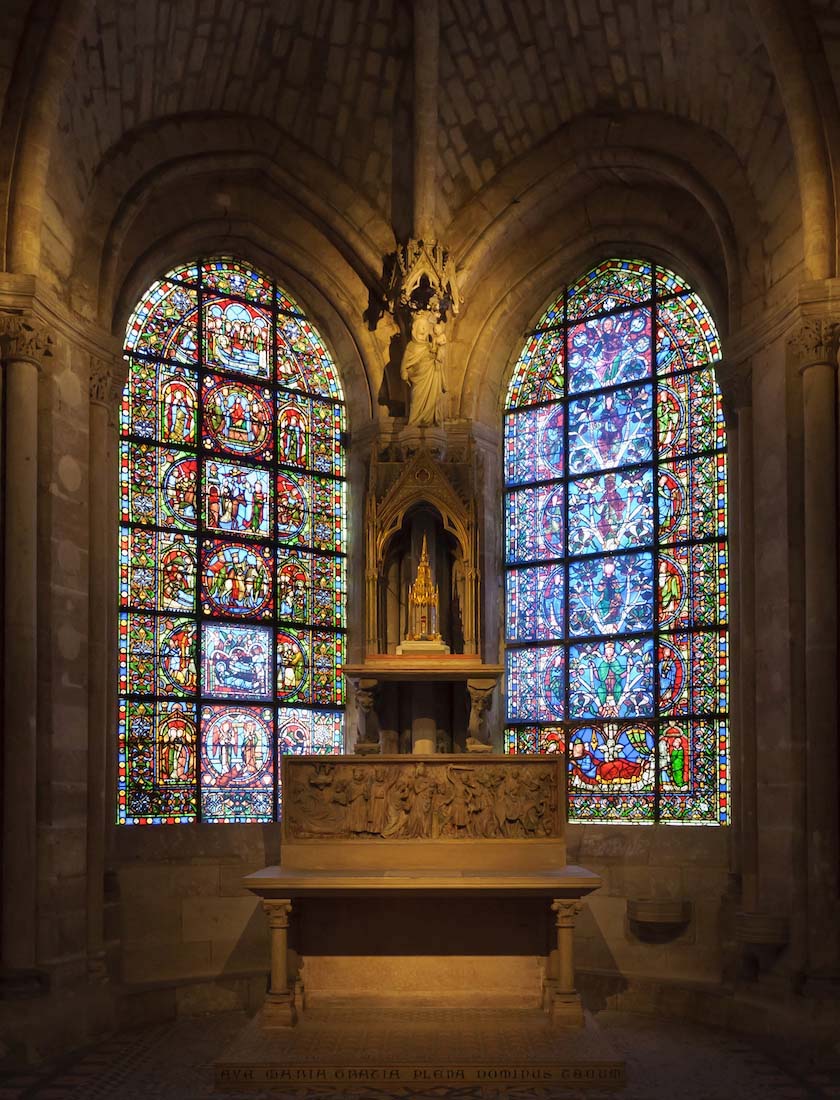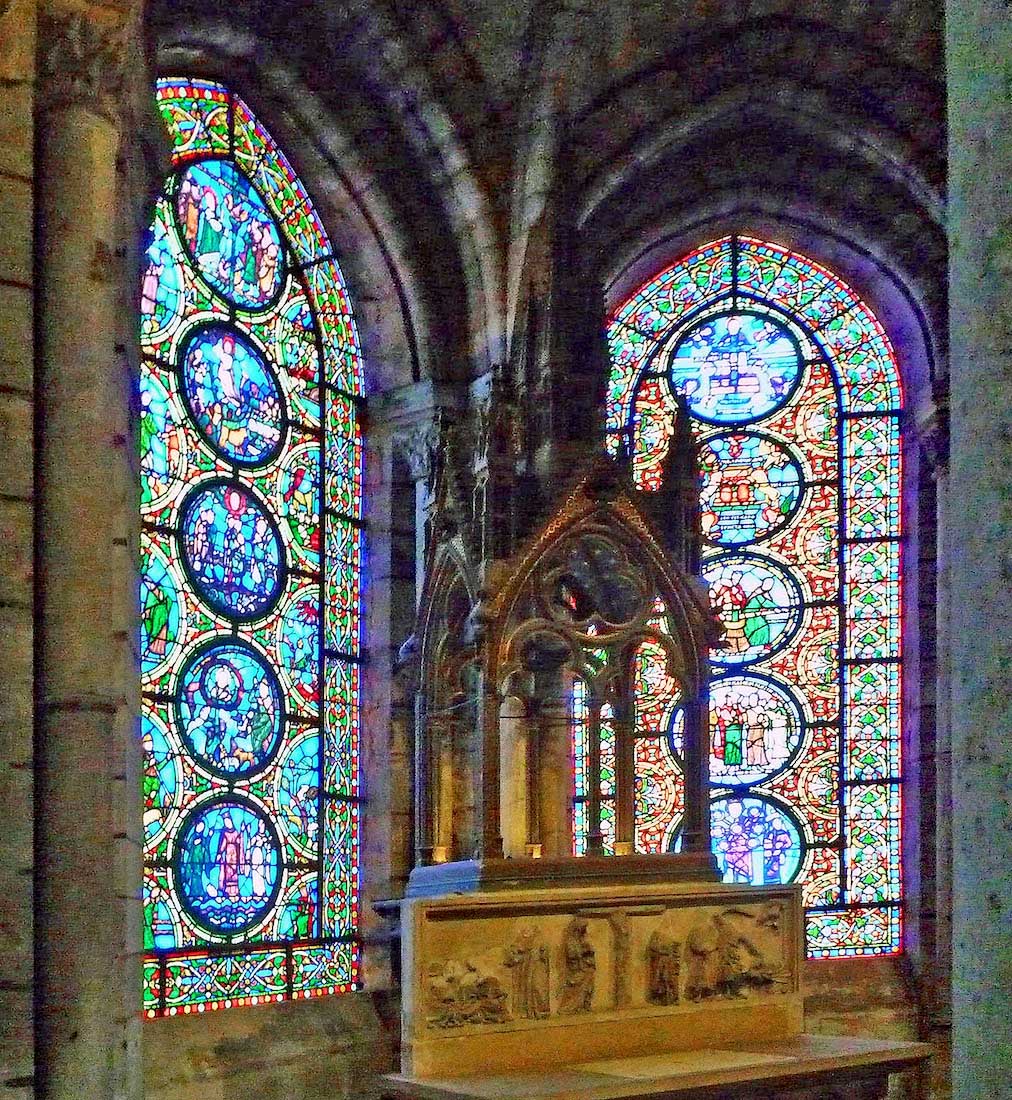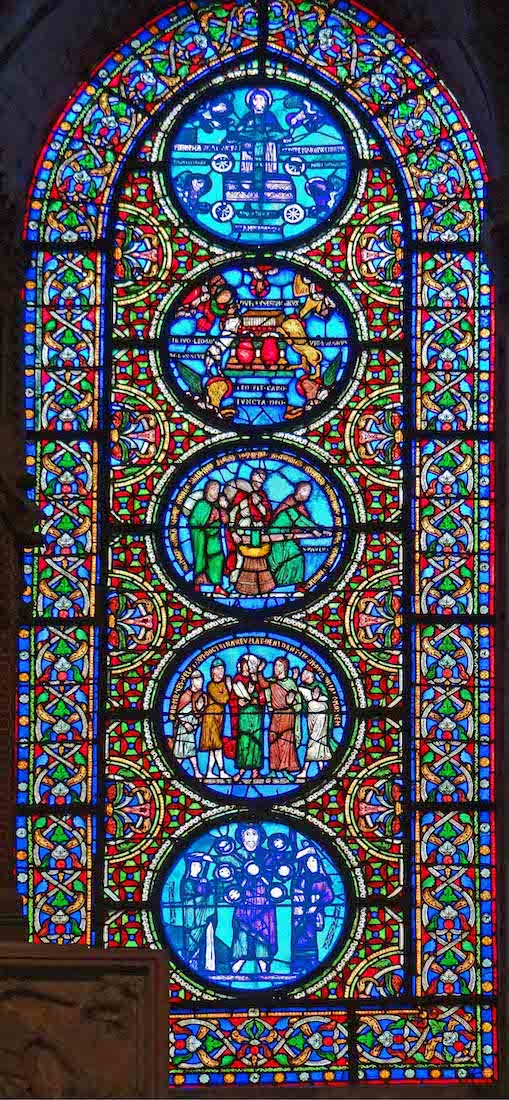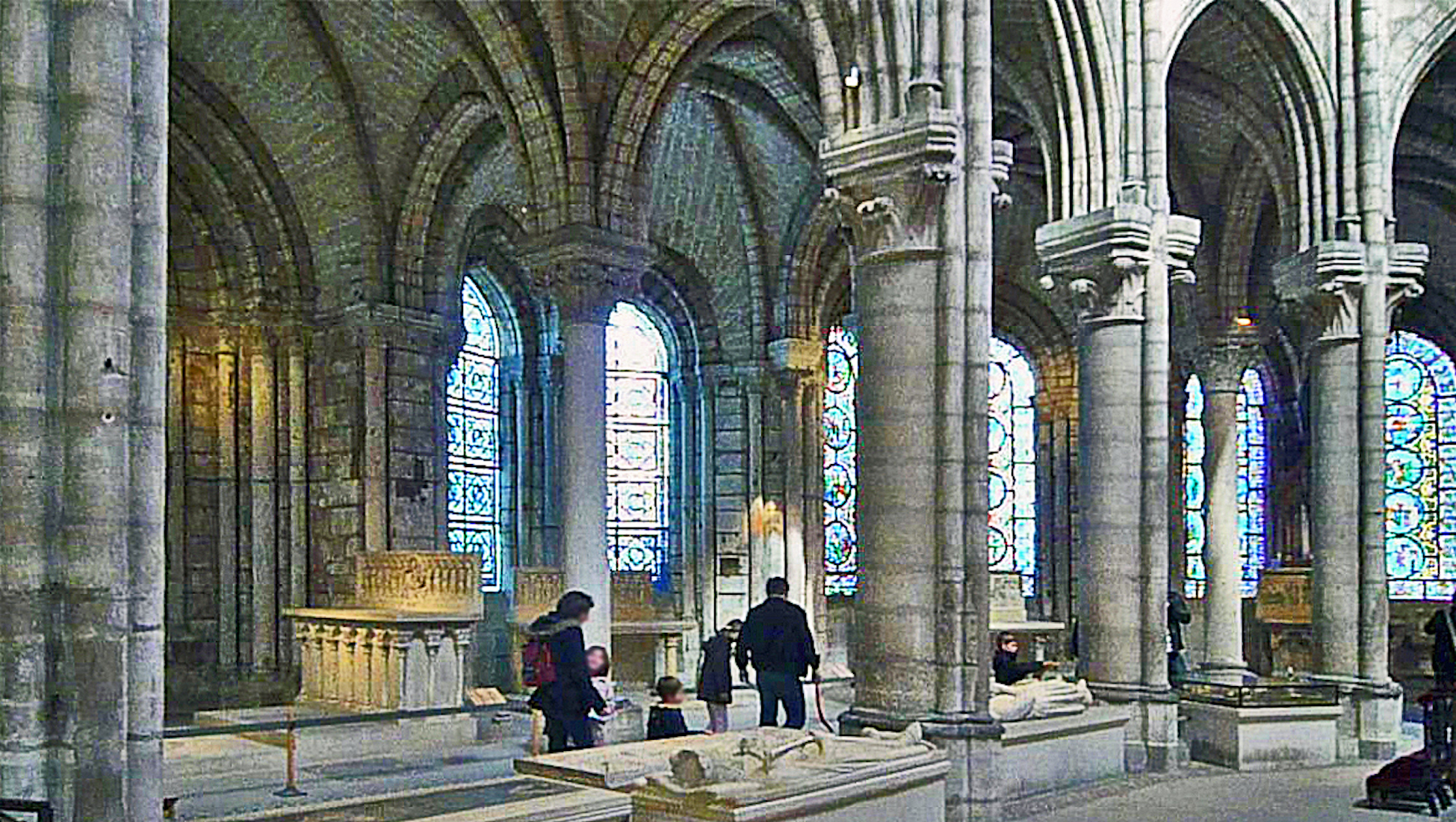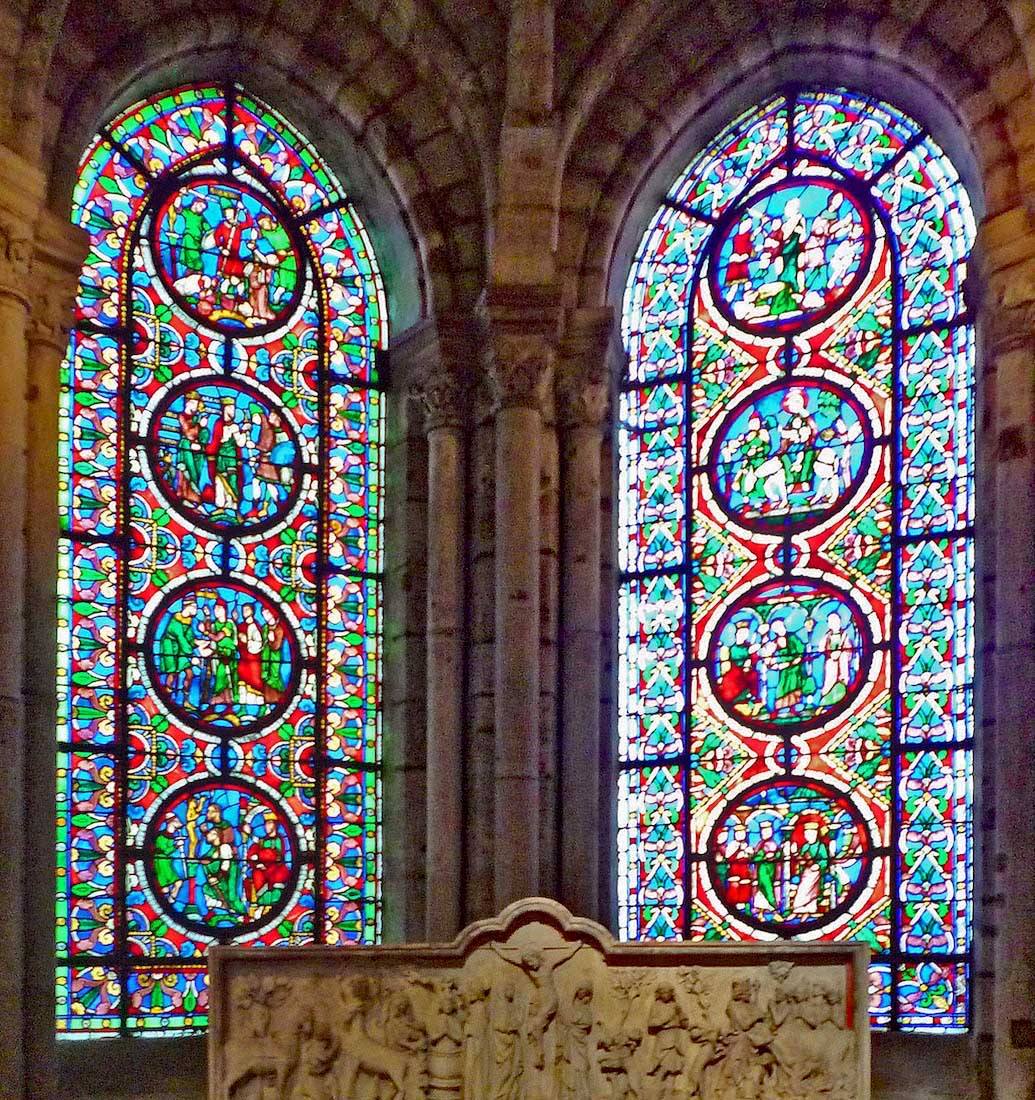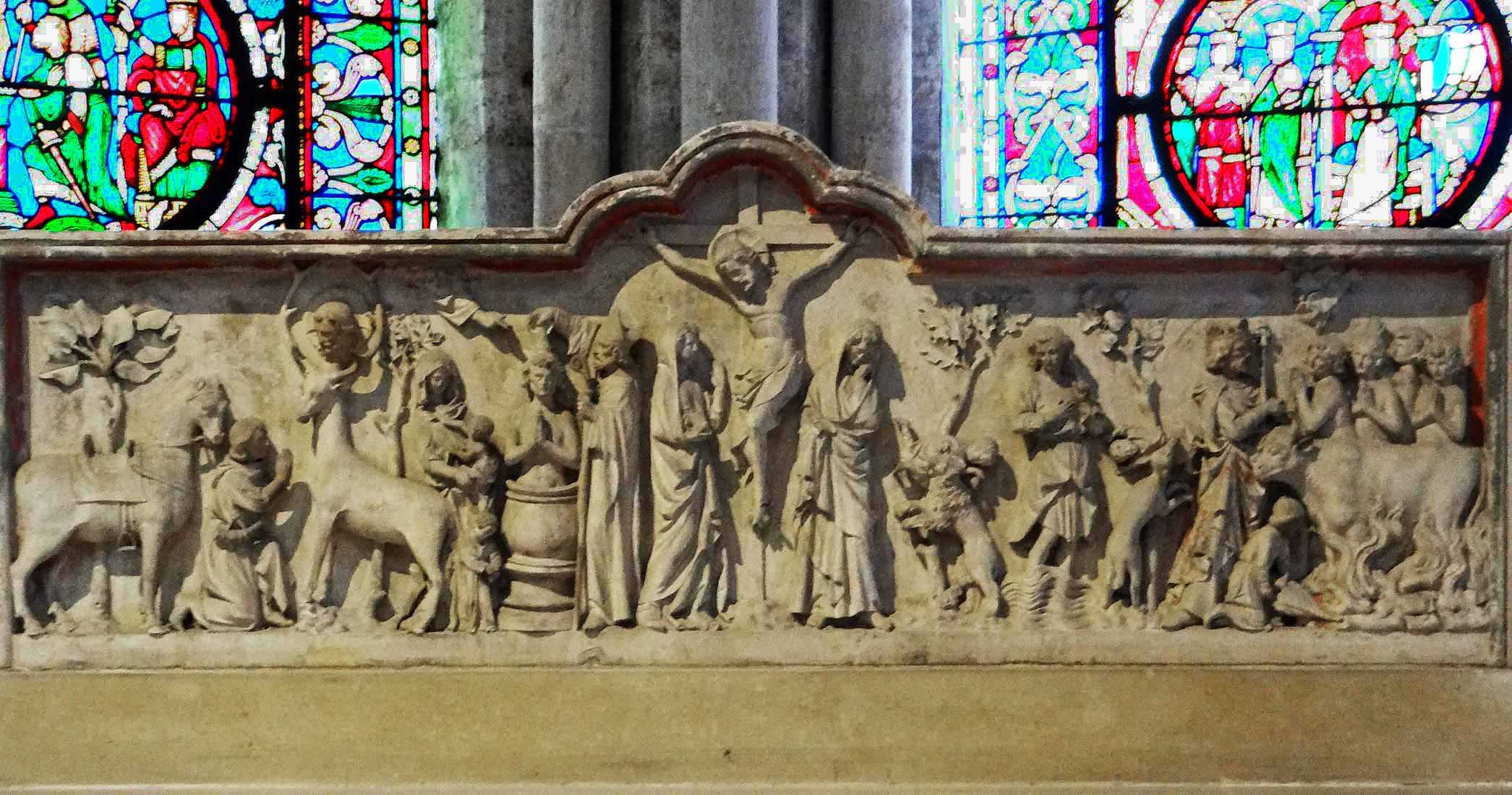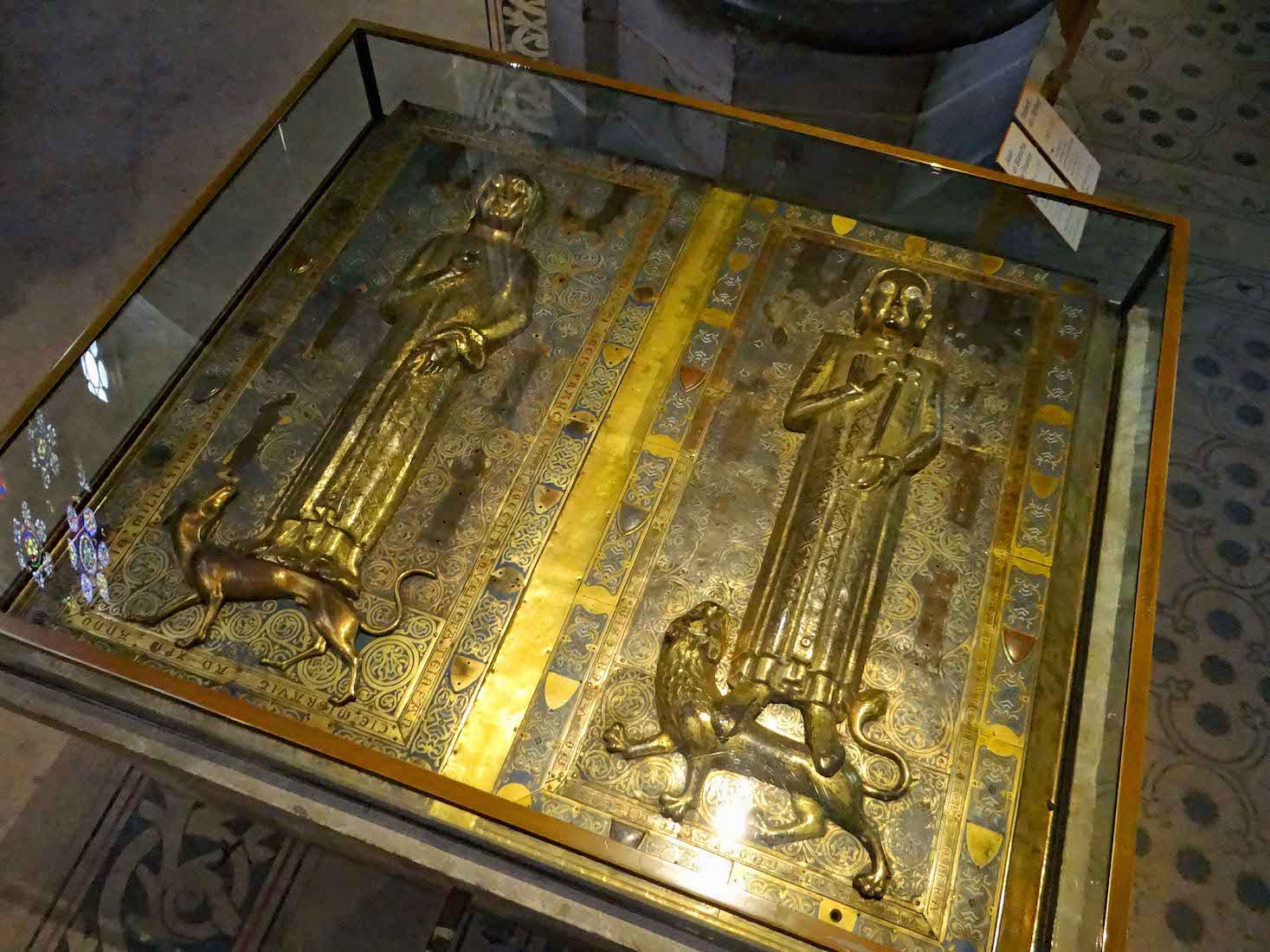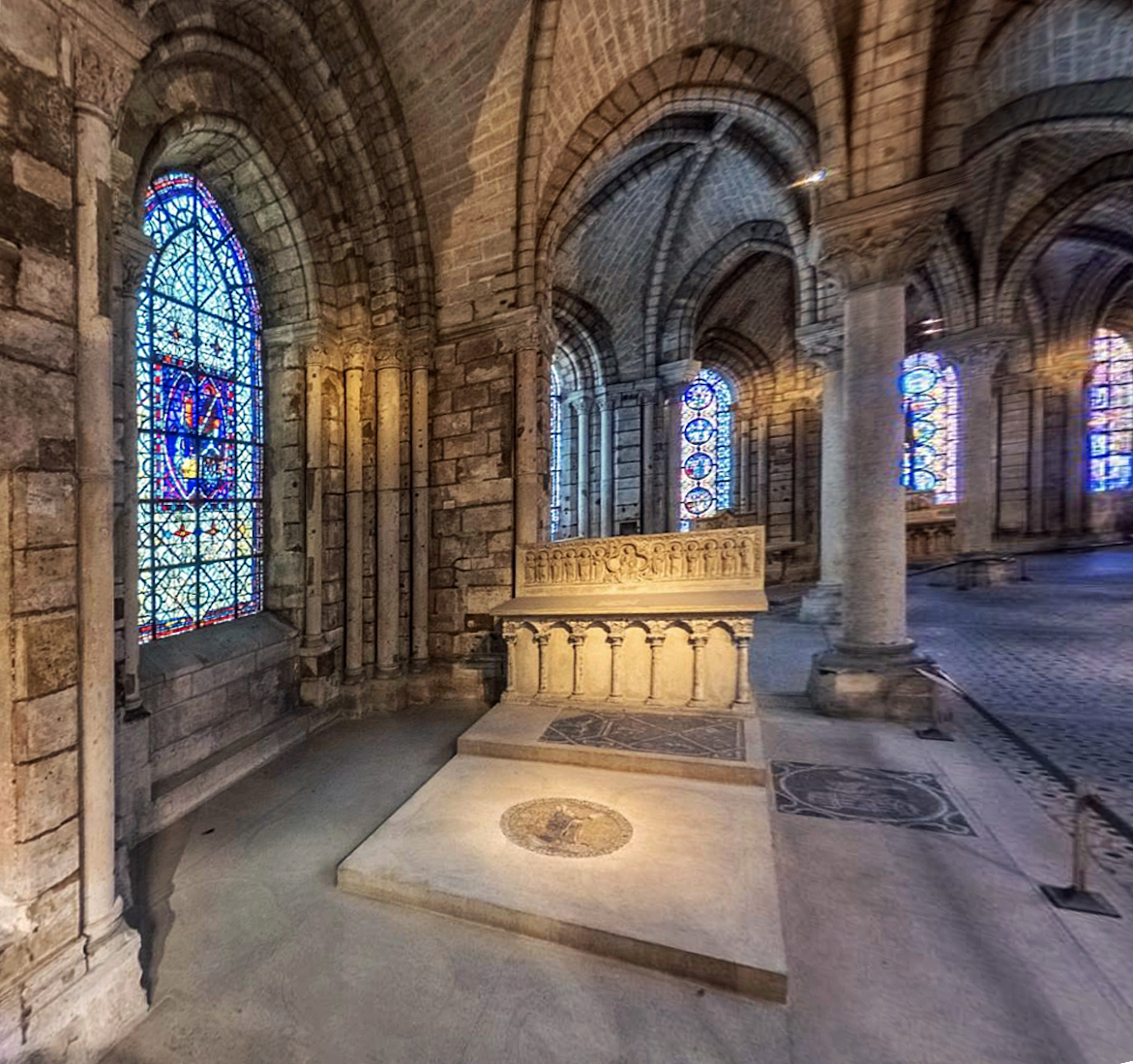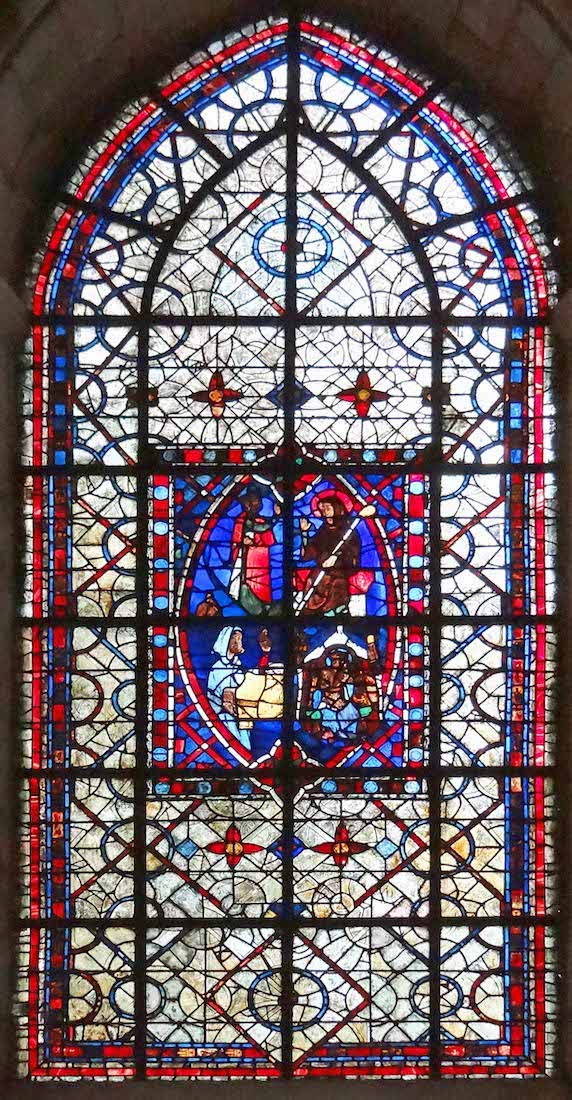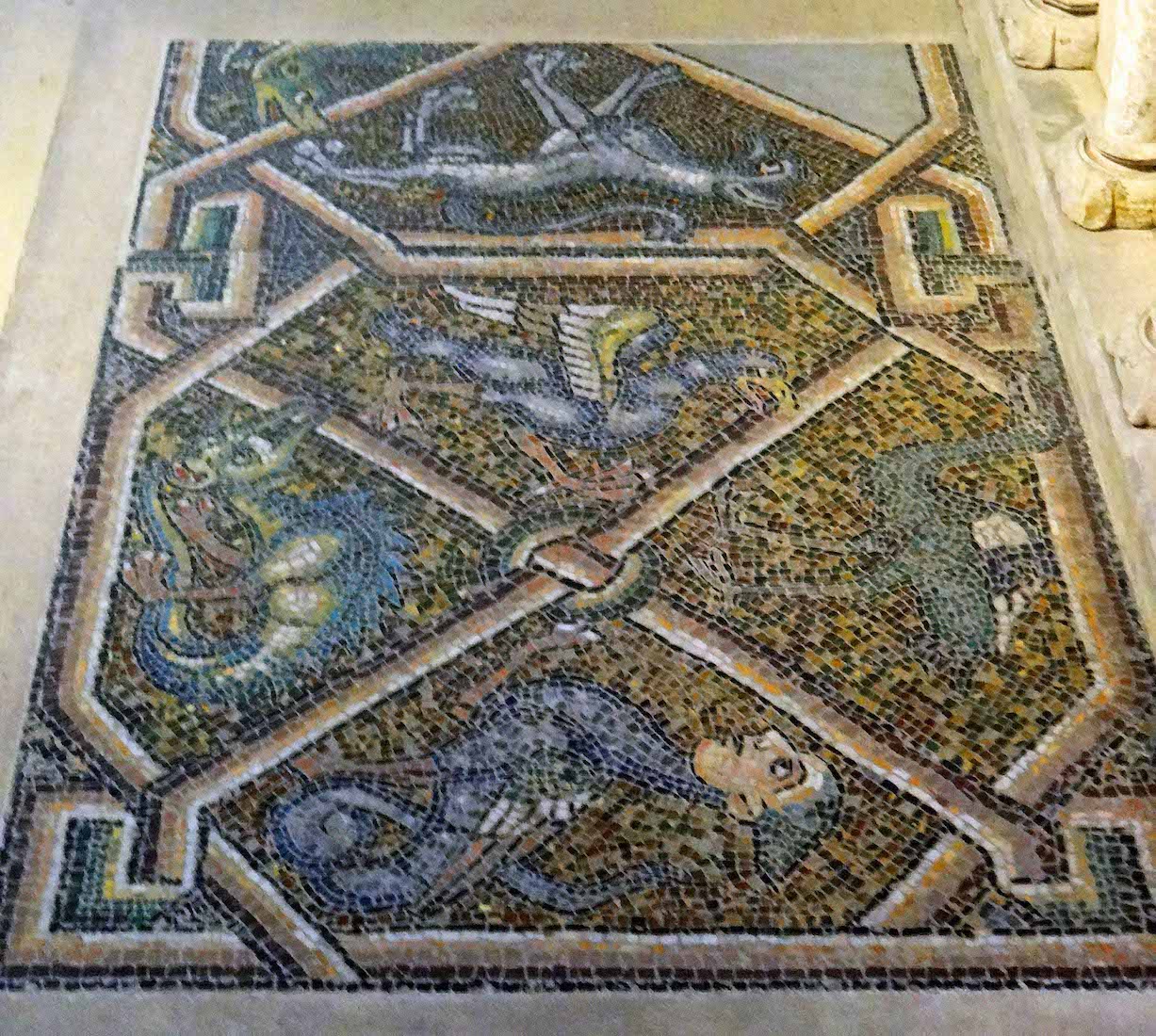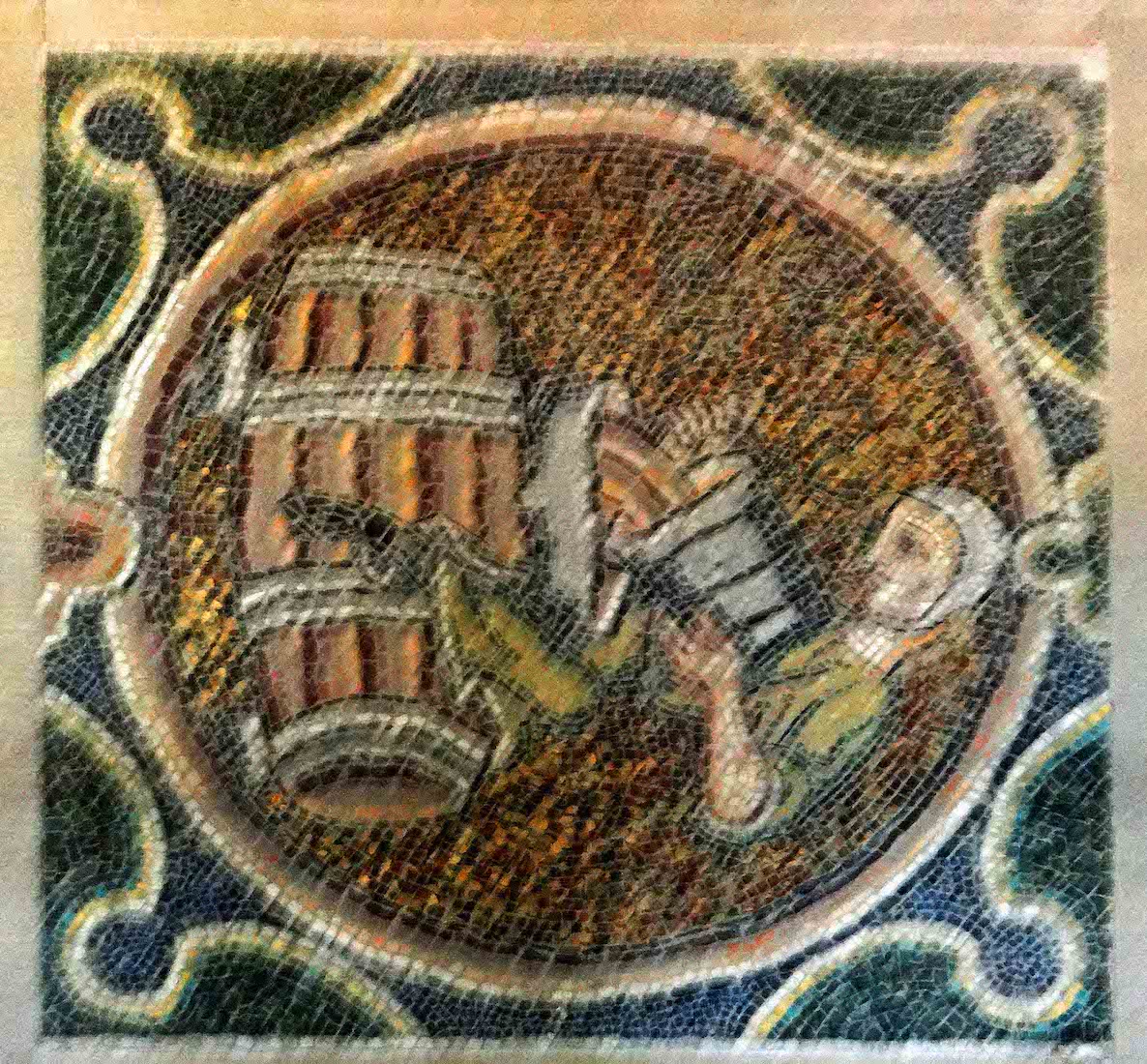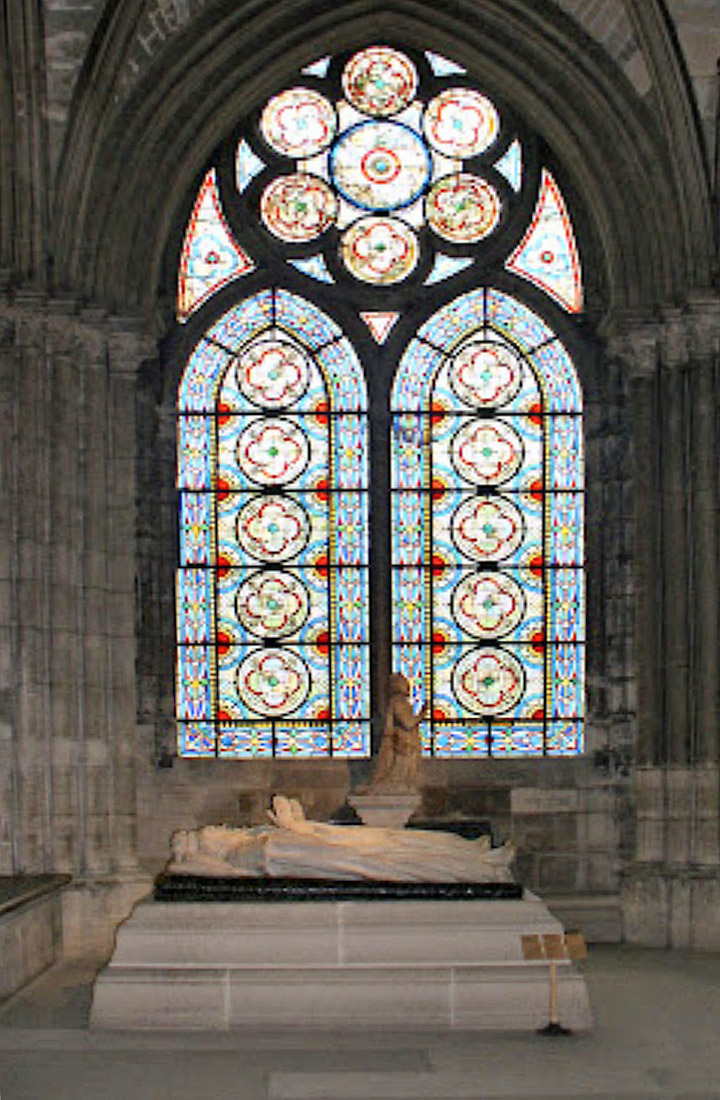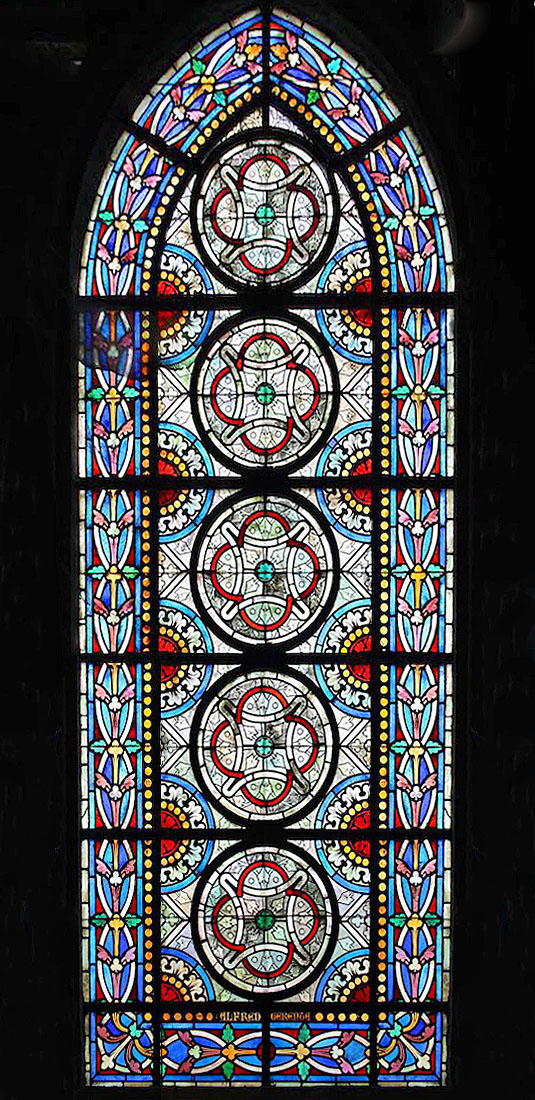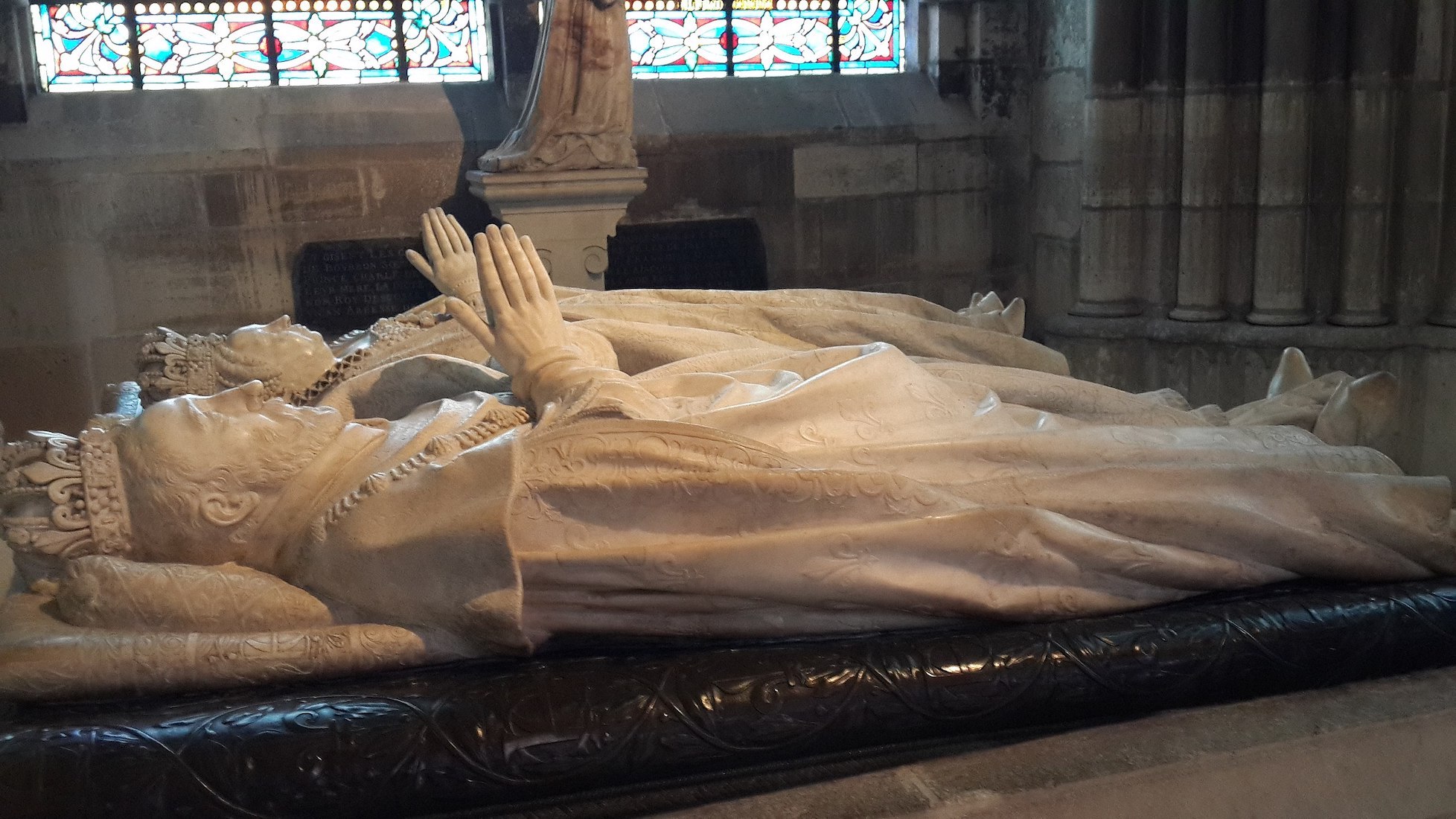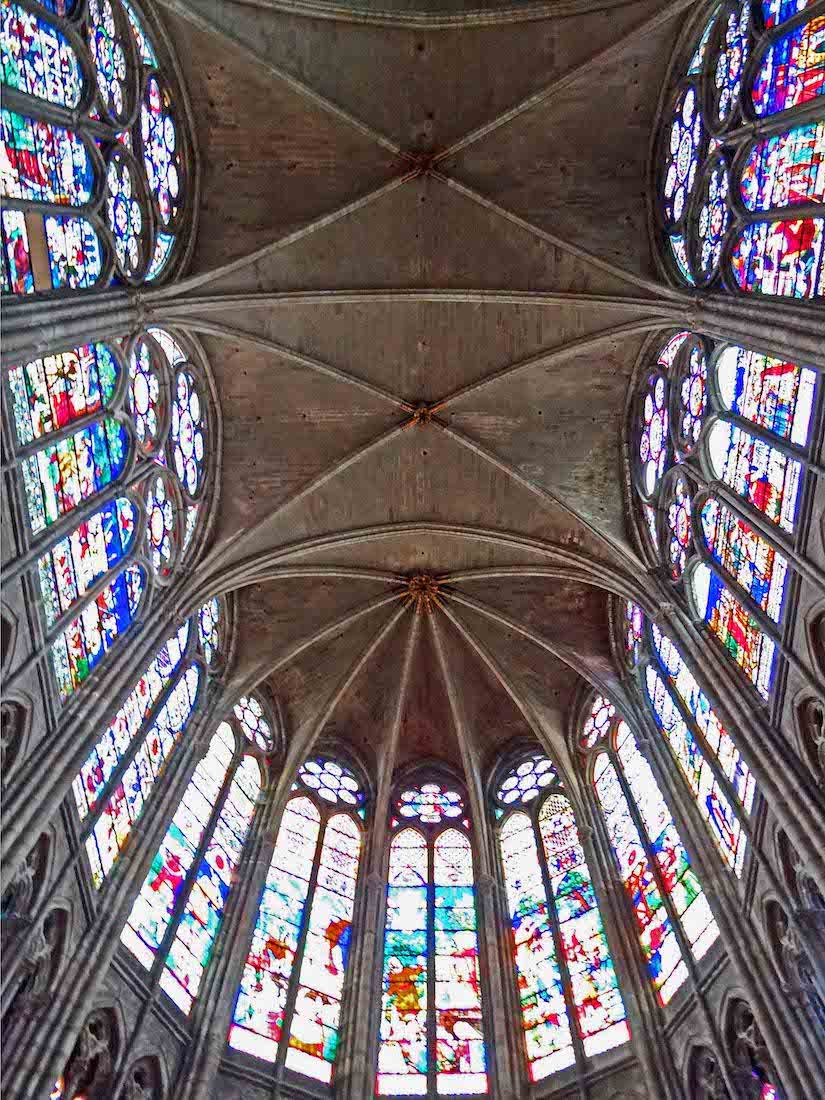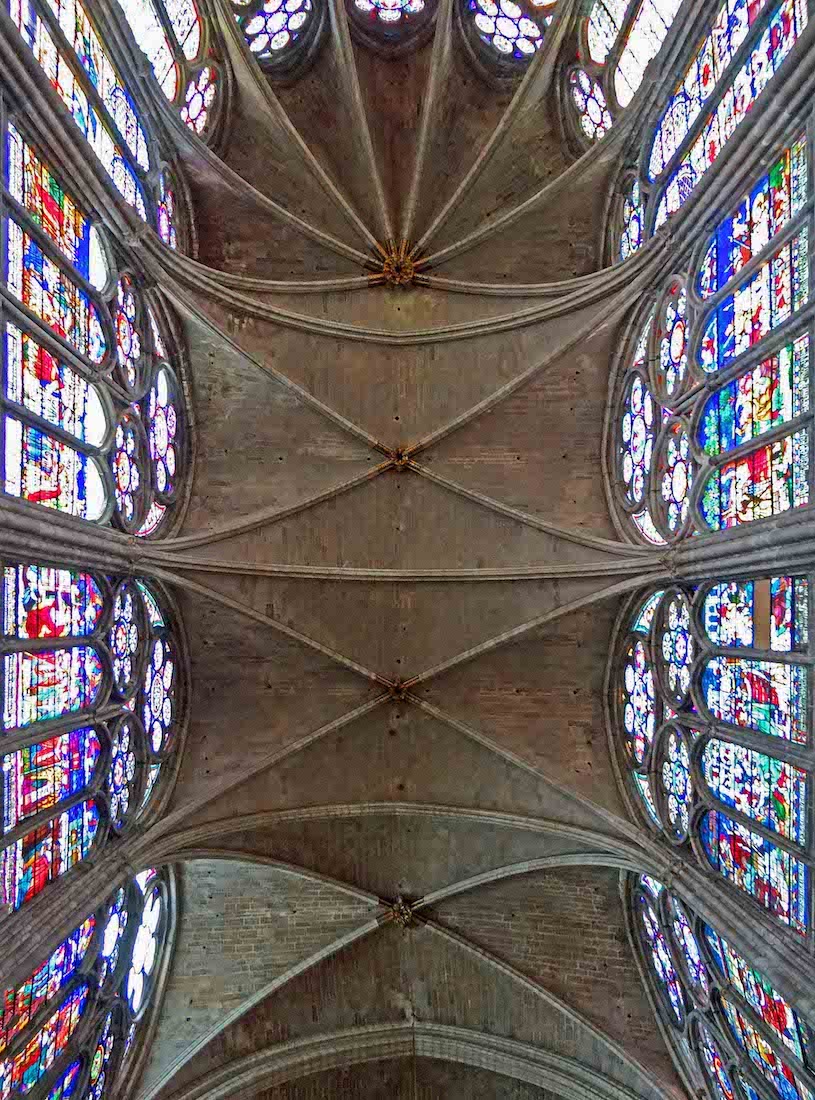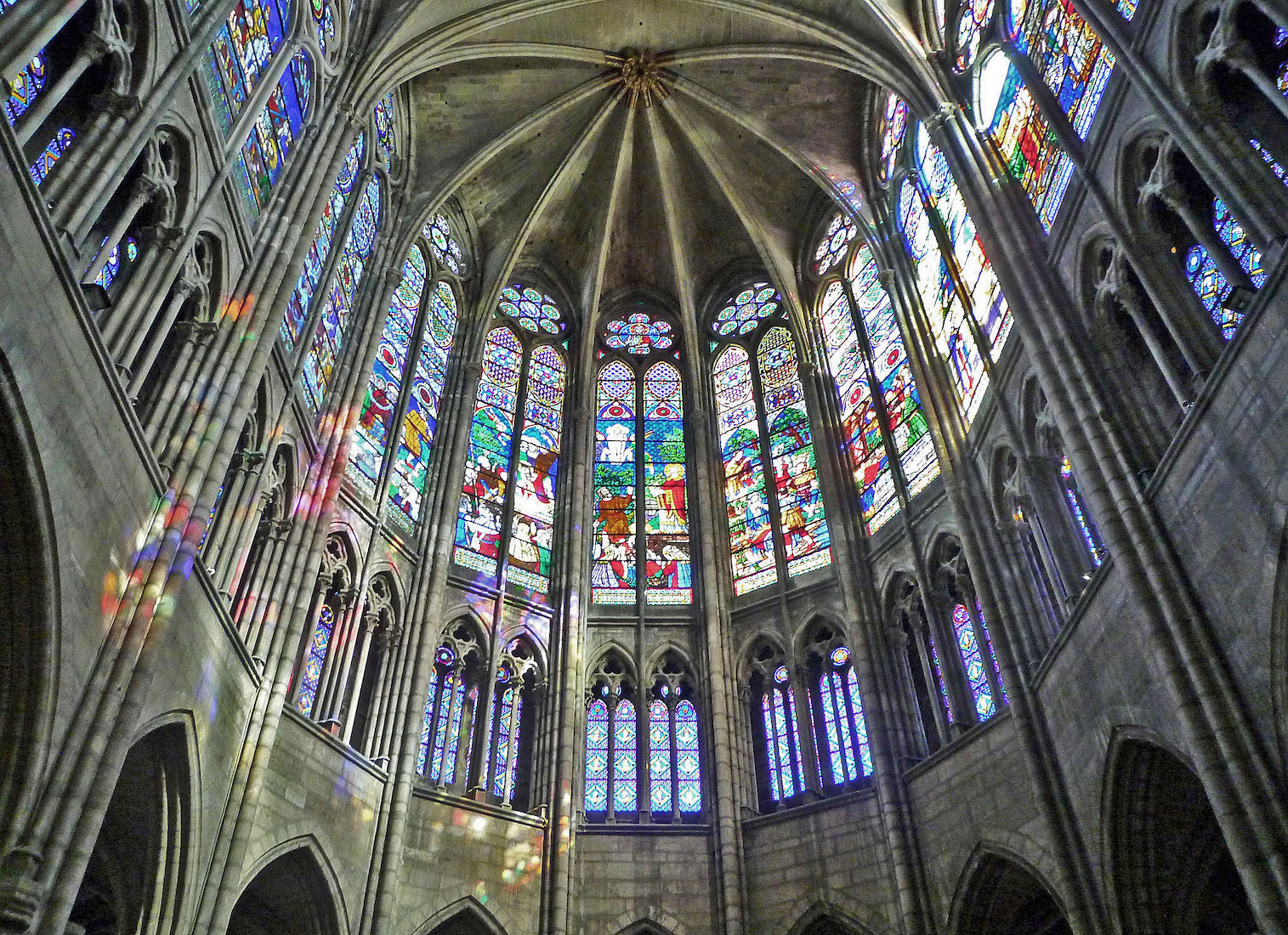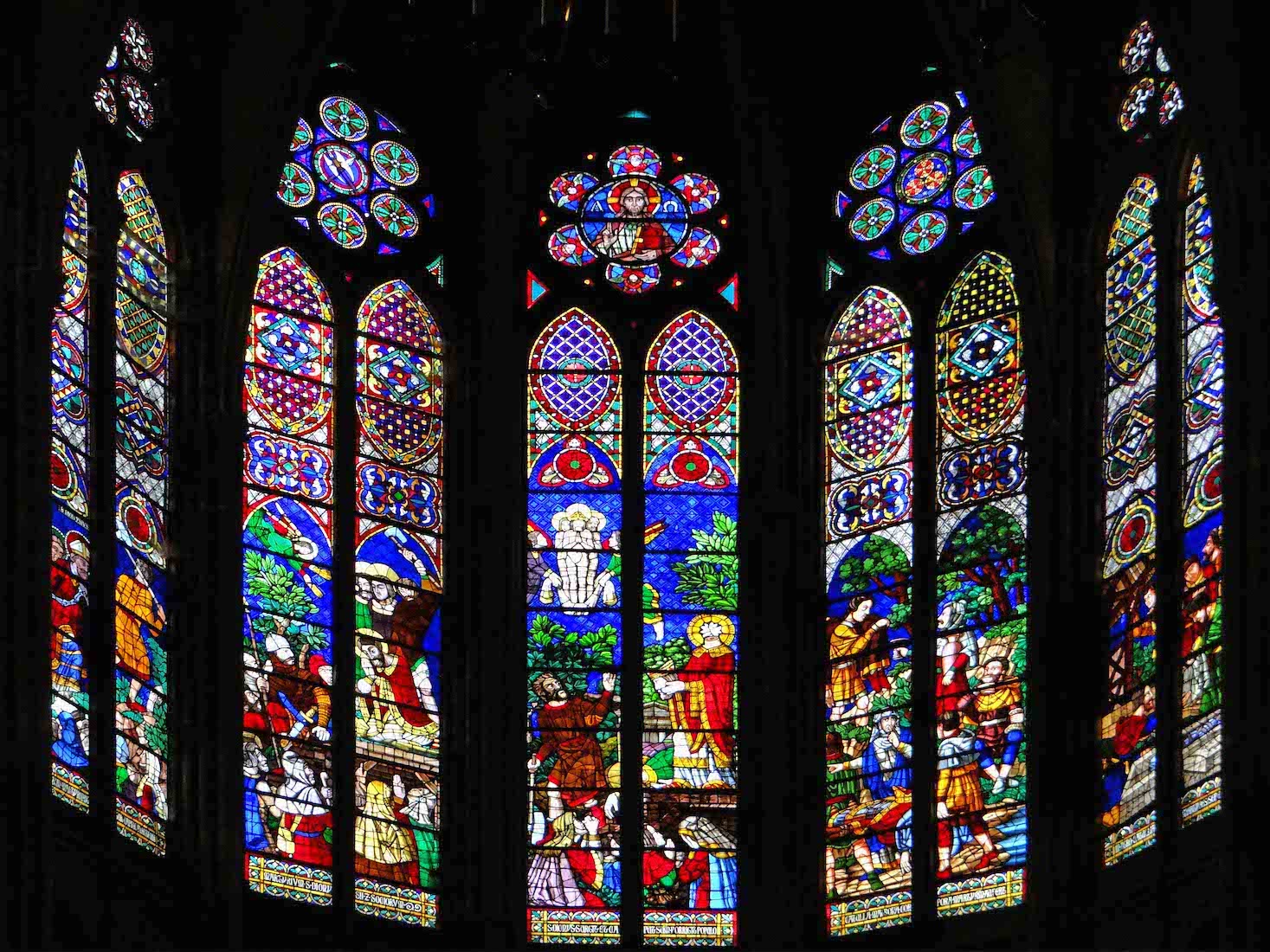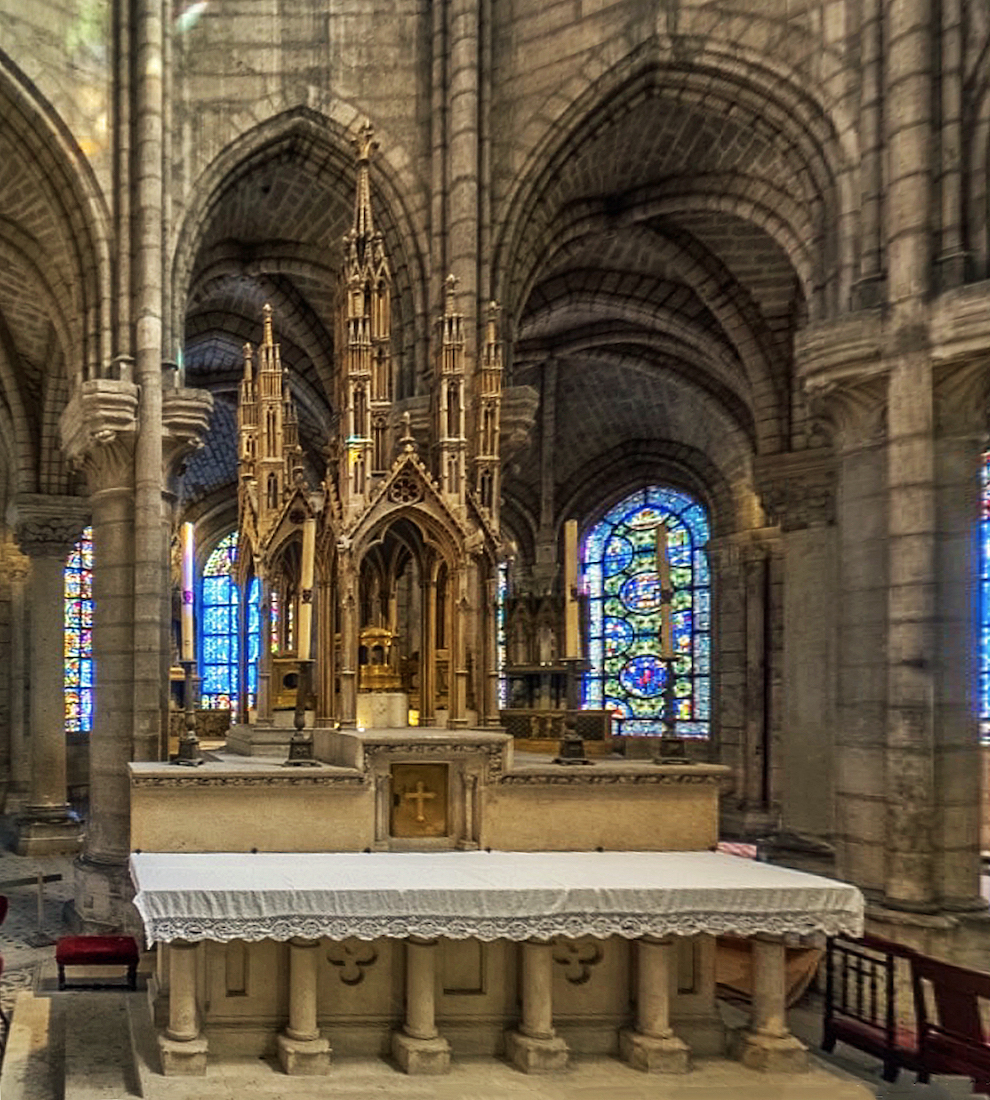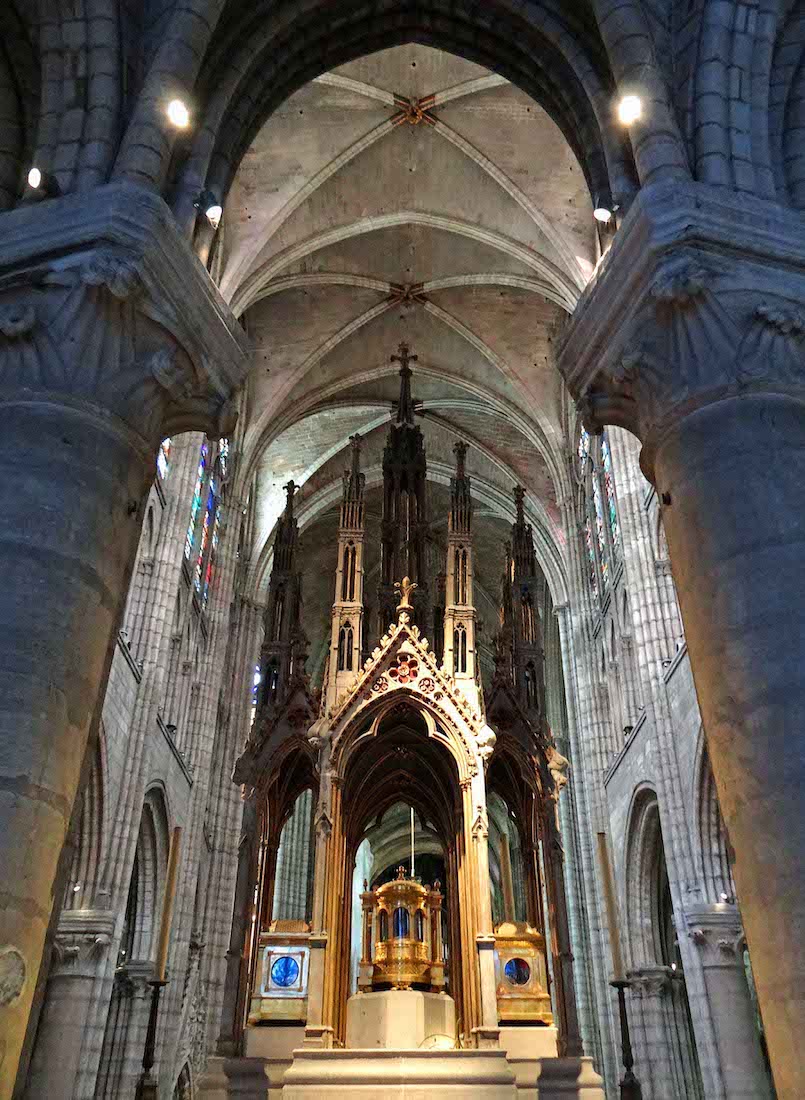63. SOUTH AMBULATORY SZ
Now to the sanctuary area. The high altar and sanctuary are surrounded by a semicircle of effigy tombs, a walkway, and then a further semicircle of ‘chapels’ – niches having a small altar and a pair of angled enclosing windows. We shall use the more common word ‘ambulatory’ here, but technically it is a ‘disambulatory’ – not for real! – with the component parts separated by columns, rather than walls. Reliquaries of various saints are displayed in the small chapels radiating out from the ambulatory, while the reliquary of St Denis is located behind the main altar. We observe that with French Gothic architecture, the word ‘chevet’ is often used to describe this apsidal arrangement of high altar and radiating chapels. [Photo Credit: Steven Zucker] INDEX
64. ST JOSEPH CHAPEL SZ
Starting on the South side, we first come to the Chapel of St Joseph (#4 on the Plan). The windows are 12th Century ‘Griffin’ windows – you can see the griffins. The windows have been much restored but there remains a significant amount of original glass. The altar panel contains twelve figures – presumably the twelve disciples. Details of the 12th century windows around the ambulatory can be found here. [Photo Credit: Steven Zucker]
65. ‘EZEKIEL’ CHAPEL RH RH
We miss a chapel and come to what would be Chapel #6 in the Plan. This is the Chapel of Saint Cucuphas, a Spanish saint who was martyred in 304 for preaching his Catholic faith. His relics are enshrined in this reliquary. The front of the altar in this chapel shows a simple crucifixion scene. But it is the left ‘Ezekiel’ window which is of most interest with the central panel (now a replica) containing 12th century glass. The window shows scenes from the life of Ezekiel, with most of the panels being 19th century restorations.
66. AMBULATORY SD
We continue our walk around the ambulatory. Some of the window panels have been removed for safe keeping, and replaced by photographic replicas. Five windows here remain from Abbot Suger’s ooriginal stained glass, but they have been damaged and reassembled.
67. AMBULATORY W-M
We continue our walk around the ambulatory. This is the Chapel of the Virgin. Some of the window panels have been removed for safe keeping, and replaced by photographic replicas. [Photo Credit: Wikimedia-Myrabella]
68. INFANCY WINDOW AND TREE OF JESSE WINDOW RH RH
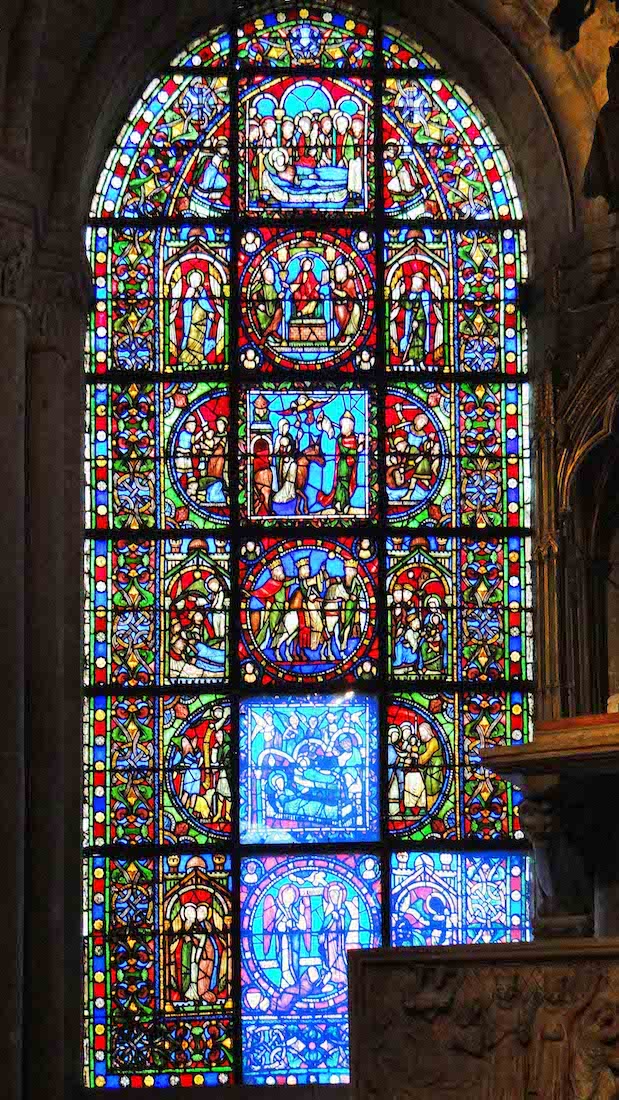
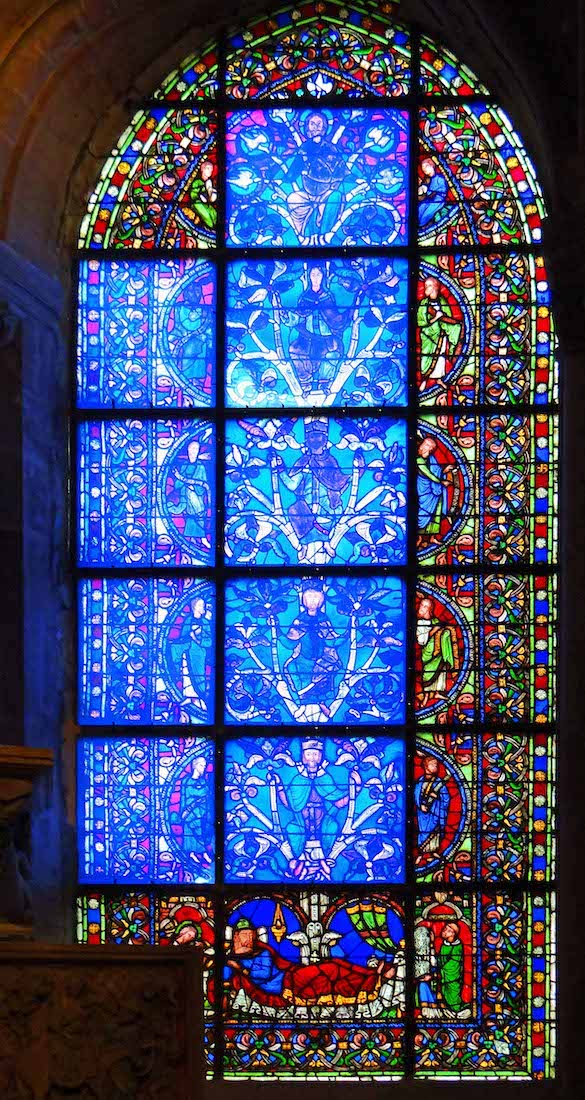
Looking more closely at the windows of the Chapel of the Virgin. The window at left is called the ‘Infancy’ window, and shows scenes from the very early life of Christ. Thus the central panels from the top show the death of the Virgin(!), the boy Jesus in the temple, the flight into Egypt, the Magi, the Nativity and the Annunciation. The window at right shows the Jesse Tree, representing the genealogy of Christ from Jesse, the father of King David. Both of these are 12th century windows. On the altar is a reliquary of St Louis, King Louis IX (1214 – 1270). It is in fact his jawbone.
69. SANCTUARY AREA SZ
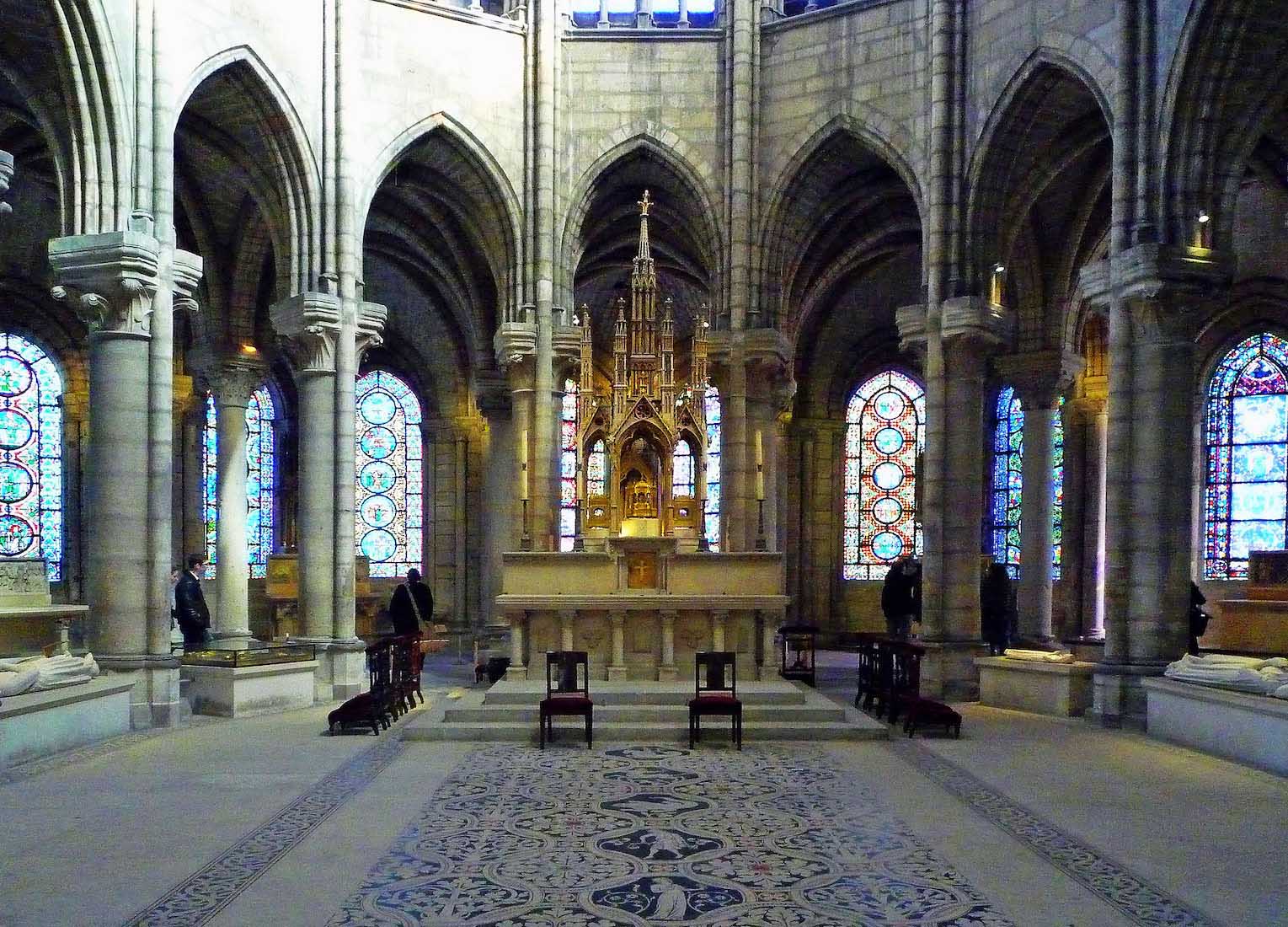
The high altar is shown here, but our purpose is to illustrate the windows and chapels of the ambulatory. We shall return to the high altar! [Photo Credit: Steven Zucker]
70. NORTH AMBULATORY CHAPEL SZ RH
This is the Chapel of St Peregrine. Peregrine of Auxerre was martyred around 261. He is honoured as the Bishop of Auxerre, a town southeast of Paris, and the builder of its first cathedral. Peregrine angered the governor after the saint urged the populace to abandon pagan idols; the inhabitants had been dedicating a new temple to Jupiter. The chapel contains two old 12th century windows. The window at left is the Moses window, and is the best preserved of the 12th century windows in the Basilica. Each of the five panels portrays an event in the life of Moses. The window at right is called the ‘Anagogical’ window or ‘Allegories of St Paul’ window. Only two of its panels contain the original glass. [First Photo Credit : Steven Zucker]
71. NORTH AMBULATORY SZ
We now view the Northern arc of the ambulatory. Looking at the effigy tombs, we see at right an unusual pair of gold effigies in a glass case. The chapel radiating out from that is The Chapel of St Eustache. The chapel left of this, behind the family, has the intriguing name ‘Chapel discovered by Crosby’, bur I have no idea why. At left is the final chapel in this series. [Photo Credit: Steven Zucker]
72. CHAPEL OF ST EUSTACHE SZ RH
Saint Eustace (Eustache) was a Roman general of the second century AD. He was a passionate hunter; his conversion followed a vision he had of a crucifix in the horns of a deer he was hunting, He was martyred, along with his family, for converting to Christianity. He is now the patron saint of hunters. There is a church near Paris which was named for Saint Eustache after receiving relics related to the Roman martyr as donations from the Abbey of Saint Denis.
73. GOLDEN EFFIGIES RH
The golden effigies belong to Blanche of France (1243) and Jean (1268). They were daughter and son of Saint Louis and of Marguerite of Provence. Saint Louis erected a tomb in memory of his two children who died young and who were buried at the Abbey of Royaumont, the family necropolis. The recumbent effigies of Blanche and Jean, precious evidence of Limousin enamel art of the thirteenth century, are among the rarest metal tombs preserved.
74. FINAL AMBULATORY BAY SD RH
The final chapel in this arc is the Chapel of St Fermin (Firmin). Fermin was a legendary holy man and martyr, traditionally venerated as the patron saint of Pamplona, the capital of Navarre, Spain. His death may be associated with either the Decian persecution (250) or the Diocletianic Persecution (303).
75. MOSAICS RH RH
Originally, the entire chevet of St. Denis was paved with mosaic tiles. These are the only remaining fragments, in the Chapel of St Firmin. Pictured here is the Mosaic of Fantastic beats (left) and Labour of the Month (October, wine being poured into a barrel) (right). • A smaller round mosaic shows the Picture of a Kneeling Monk, his hands raised in a gesture of prayer.
76. HENRI II AND CATHERINE BB W-F
We follow around from the end of the ambulatory to a small open chapel in which lie the effigies of Henri II and Catherine de Medici. The statue of Marie de Bourbon Vendome stands behind and faces towards the window at right – attractive and abstract. [Right Photo Credit: Wikimedia-Freihalter]
77. WINDOW W-H
Henri and Catherine are wearing their coronation robes and have their eyes wide open. A (partly visible) sculpture of Marie de Bourbon Vendome stands behind. The statue of Marie de Bourbon Vendome faces towards this window – attractive and abstract. [Photo Credit: Wikimedia-Yair Haklai]
78. LOOKING UP AT THE APSE RH RH
Finally we come to the central apse, looking up at the arched vaulting and the splendid colourful array of stained glass. A great benefit of the ‘new’ Gothic architecture was its ability to fill a space with glorious light and colour.
79. APSE WINDOWS SZ
Not only could the clerestory windows be greatly lengthened, but the triforium layer could also be filled with colourful glass. [Photo Credit: Steven Zucker]
80. WINDOW DETAILS RH
The central lancets illustrate the martyrdom of St Denis. We see that St Denis is holding his head which has been chopped off. A legend recorded in the 9th century recounts that Denis was beheaded on Montmartre and that his decapitated corpse carried his head to the area northeast of Paris where the Benedictine abbey of St. Denis was founded. Denis is often portrayed in art as a decapitated (though evidently living) figure. More apse window details can be found here.
81. HIGH ALTAR SD
At the centre of the chevet, there is a simple altar. Four candles stand on the low screen behind, and an aumbry is set into the screen at the centre. Today, the relics of St Denis are conserved in a shrine located just behind the main altar.
82. A FINAL MEMORY RH
This completes our tour of the Basilica Cathedral of St Denis. Definitely worth an actual visit!
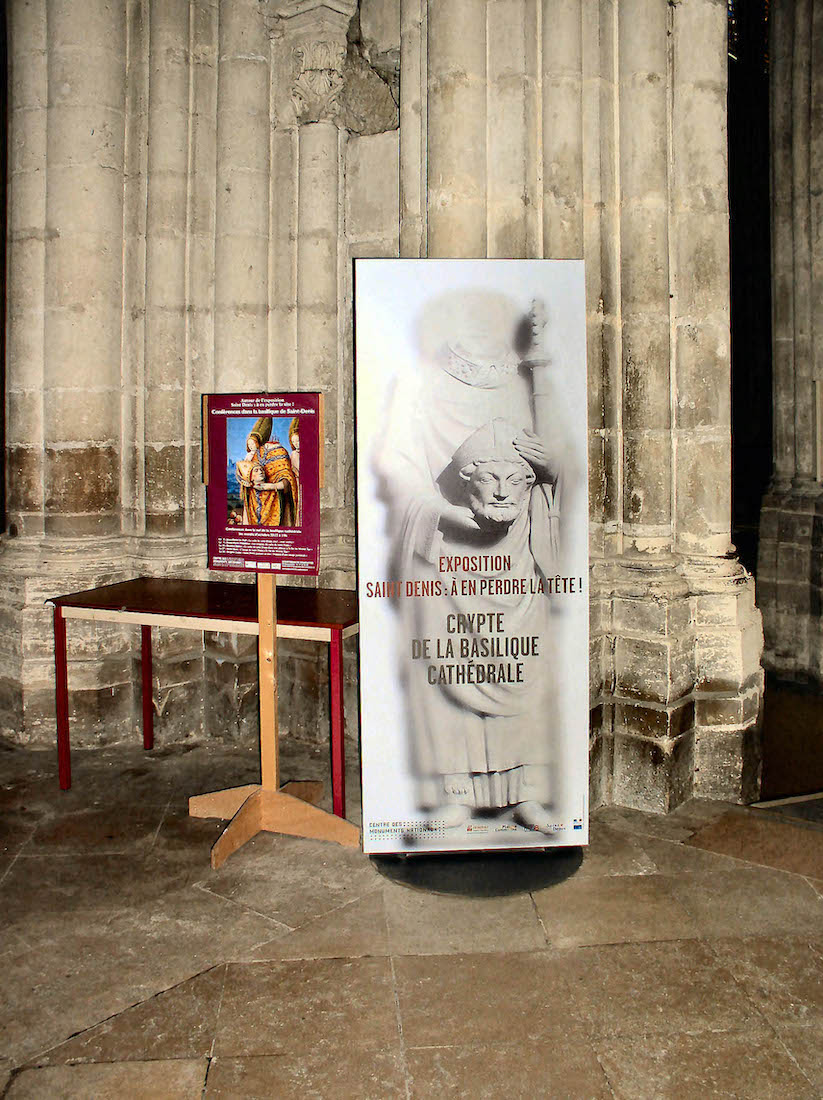
CONCLUSION
Before embarking on this website, I had never heard of the Basilica Cathedral of St Denis. It has been a fascinating voyage of discovery for me, and I hope you have enjoyed visiting it too.
None of the photographs on this site are mine. There are two main contributors: ‘Rex Harris, and ‘Glass Angel’ with whom I have enjoyed working previously. Ownership is indicated by the initials RH and GA in the titles. The original photos can be found with these links:
RH: https://www.flickr.com/photos/sheepdog_rex/albums/72157692852113071
GA: https://www.flickr.com/photos/47859152@N05/albums/72157719167858884
There are also half a dozen photos from Becky Bodnar’s interesting blog on the Basilica:
BB: http://frompariswithlove-becky.blogspot.com
I am grateful to Rex [RH], Mary [GA] and Becky [BB], and also to a host of other photographers who have been kind enough to contribute their photographs. Their contributions have been acknowledged in the text. I have used a number of screen shots taken from a virtual walk-through of St Denis’. I have found this very helpful; the link is
SD: https://uk.tourisme93.com/basilica/virtual-tour-of-st-denis-basilica.html
I also express my thanks to my wife Margie who dutifully reads through all my websites and checks the typing.
I take little credit for the text which comes from a variety of different sources including the invaluable Wikipedia. I apologise for any incorrect translations due to my inadequate boyhood French!
I would be glad to receive any comments, criticisms or corrections to this site. The best websites are those which contain no errors!
St Denis’ Basilica has its own website with the link
http://www.saint-denis-basilique.fr
Site created 02/2022
Paul Scott

